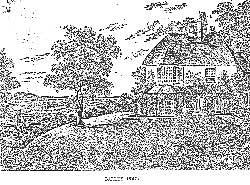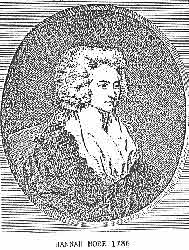|
She encouraged the sale of the halfpenny tract, writing the stories herself on many occasions, for she said it was no good to teach the poor to read and not supply that need with stories of high moral tone, or some unscrupulous vendor would fill the gap! She wrote The Riot, said to have helped to stop the Bristol riots - very questionable one would think today.
Against drink, The Gin Shop, The Lady and the Pie, Dan and Jane and many others. All in all, one million tracts were sold, some finding their way to the U.S.A. where they sold so well that the profits from these were used to found a girls' school in Ceylon named Barley Wood.
She was so well thought of that a girls' school in Jeffery Centre, Newhampshire, was named after her and, only very recently, was amalgamated with another school whose headmaster visited Bristol last year on a Hannah More Pilgrimage.
This, then, was the origin of tracts, those little papers which enlightened our forefathers when they started to read. Many could not afford books but were hungry for reading matter.
Her poems and ballads were comments on the society of her day. Her larger works such as Coelebs in Search of a Wife (a long discourse on Christian morality, with the story line of Coelebs' travels to find his bride Lucilla) brought much approval and criticism.
She expressed her disapproval of the emphasis on fashion and fripperies, and thought young ladies should put their minds to more serious subjects. A very long volume was Hints for Forming the Character of a Princess. One of the clergy had suggested she should do this, as it was thought the Prince of Wales, who was to become George IV, was not a good influence for a future Queen. The Princess was, of course, Charlotte, sho sadly died in childbirth.
Hannah had been presented to the Royal Family. She tells of her visit to King George III and his Queen and how the little Princess was asked to dance for her.
Thoughts on the Manners of the Great was a criticism of the life of the rich and idle and famous people of her day. She told Burke, the MP: "The public and private man are one and the same, for the one reflects the other; you cannot say one thing in public and do the opposite in private life. What are your servants to think if they see you publicly condemn one thing and do the same privately?"
For her epitaphs, odes and amusing poems, she was acknowledged as a great wit in her younger days. She had such a lively mind, one wonders when she found time to sleep, or entertain her friends but she did and still went to London on occasions.

After the move to Barley Wood, where the four sisters joined her and where she says she never found the retirement she sought, how the village of Wrington must have talked of all those famous visitors at the big house.
She says she entertained more friends and strangers than even in her gayest days. They included the Duke of Gloucester, the Wilberforce family, the Thorntons, Mrs.Siddons and, we learn, Mr.Gladstone, as reported on Page 8 of Mendip Schools.
Many clergy also visited including her close friends the Bishop of London and his wife Belby Porteous. When he died she put an urn in the garden of Barley Wood to his memory.
There was a very large party in 1819 when, she says, she "entertained 120 ladies and gentlemen, the superior part of the company, to a dinner of cold collation served on flower-decked table in the garden. White-robed nymphs made it the prettiest show imaginable."
By the time this took place, Hannah and Patty were alone. Mary had died in 1813, Elizabeth in 1816, Sarah in 1817. This sadness inspired Hannah to get her tracts published. All her life, Hannah had suffered much ill health, and she became more and more housebound.
In 1819 Patty died and Hannah was alone. A Miss Frowd became her companion. She stayed more and more in her first floor room. Still her pen found things to say but friends were becoming very concerned for the little lady at Barley Wood. One could go on and on and still not exhaust the stories of the life and work of Hannah More..
|
|
moral tracts
schools inspired by her
disapproval of fashionable frivolity
royal family connection
continuing entertaining of visitors
Bishop of London
death of her sisters
her own decline

|
|
|




